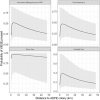Insights from the first global population estimate of Weddell seals in Antarctica
- PMID: 34559555
- PMCID: PMC8462891
- DOI: 10.1126/sciadv.abh3674
Insights from the first global population estimate of Weddell seals in Antarctica
Abstract
The Weddell seal is one of the best-studied marine mammals in the world, owing to a multidecadal demographic effort in the southernmost part of its range. Despite their occurrence around the Antarctic coastline, we know little about larger scale patterns in distribution, population size, or structure. We combined high-resolution satellite imagery from 2011, crowd-sourcing, and habitat modeling to report the first global population estimate for the species and environmental factors that influence its distribution. We estimated ~202,000 (95% confidence interval: 85,345 to 523,140) sub-adult and adult female seals, with proximate ocean depth and fast-ice variables as factors explaining spatial prevalence. Distances to penguin colonies were associated with seal presence, but only emperor penguin population size had a strong negative relationship. The small, estimated population size relative to previous estimates and the seals’ nexus with trophic competitors indicates that a community ecology approach is required in efforts to monitor the Southern Ocean ecosystem.
Figures




Similar articles
-
Ice matters: Life-history strategies of two Antarctic seals dictate climate change eventualities in the Weddell Sea.Glob Chang Biol. 2021 Dec;27(23):6252-6262. doi: 10.1111/gcb.15828. Epub 2021 Sep 7. Glob Chang Biol. 2021. PMID: 34491603 Free PMC article.
-
Contrasting responses to a climate regime change by sympatric, ice-dependent predators.BMC Evol Biol. 2016 Mar 15;16:61. doi: 10.1186/s12862-016-0630-3. BMC Evol Biol. 2016. PMID: 26975876 Free PMC article.
-
Long term movements and activity patterns of an Antarctic marine apex predator: The leopard seal.PLoS One. 2018 Jun 5;13(6):e0197767. doi: 10.1371/journal.pone.0197767. eCollection 2018. PLoS One. 2018. PMID: 29870541 Free PMC article.
-
Ecology of southern ocean pack ice.Adv Mar Biol. 2002;43:171-276. doi: 10.1016/s0065-2881(02)43005-2. Adv Mar Biol. 2002. PMID: 12154613 Review.
-
The influence of historical climate changes on Southern Ocean marine predator populations: a comparative analysis.Glob Chang Biol. 2016 Feb;22(2):474-93. doi: 10.1111/gcb.13104. Epub 2015 Nov 20. Glob Chang Biol. 2016. PMID: 26391440 Review.
Cited by
-
Advances in remote sensing of emperor penguins: first multi-year time series documenting trends in the global population.Proc Biol Sci. 2024 Mar 13;291(2018):20232067. doi: 10.1098/rspb.2023.2067. Epub 2024 Mar 13. Proc Biol Sci. 2024. PMID: 38471550 Free PMC article.
-
Biogeographic survey of soil bacterial communities across Antarctica.Microbiome. 2024 Jan 12;12(1):9. doi: 10.1186/s40168-023-01719-3. Microbiome. 2024. PMID: 38212738 Free PMC article.
-
Where to live? Landfast sea ice shapes emperor penguin habitat around Antarctica.Sci Adv. 2023 Sep 29;9(39):eadg8340. doi: 10.1126/sciadv.adg8340. Epub 2023 Sep 27. Sci Adv. 2023. PMID: 37756400 Free PMC article.
-
Genetic diversity and demographic history of the leopard seal: A Southern Ocean top predator.PLoS One. 2023 Aug 11;18(8):e0284640. doi: 10.1371/journal.pone.0284640. eCollection 2023. PLoS One. 2023. PMID: 37566609 Free PMC article.
-
Deep learning enables satellite-based monitoring of large populations of terrestrial mammals across heterogeneous landscape.Nat Commun. 2023 May 27;14(1):3072. doi: 10.1038/s41467-023-38901-y. Nat Commun. 2023. PMID: 37244940 Free PMC article.
References
-
- Estes J. A., Terborgh J., Brashares J. S., Power M. E., Berger J., Bond W. J., Carpenter S. R., Essington T. E., Holt R. D., Jackson J. B. C., Marquis R. J., Oksanen L., Oksanen T., Paine R. T., Pikitch E. K., Ripple W. J., Sandin S. A., Scheffer M., Schoener T. W., Shurin J. B., Sinclair A. R. E., Soulé M. E., Virtanen R., Wardle D. A., Trophic downgrading of planet Earth. Science 333, 301–306 (2011). - PubMed
-
- Koch P. L., Zachos J. C., Gingerich P. D., Correlation between isotope records in marine and continental carbon reservoirs near the Palaeocene/Eocene boundary. Nature 358, 319–322 (1992).
-
- Hofman R. J., Stopping overexploitation of living resources on the high seas. Mar. Policy 103, 91–100 (2019).
-
- Trathan P. N., Wienecke B., Barbraud C., Jenouvrier S., Kooyman G., Le Bohec C., Ainley D. G., Ancel A., Zitterbart D. P., Chown S. L., LaRue M., Cristofari R., Younger J., Clucas G., Bost C. A., Brown J. A., Gillett H. J., Fretwell P. T., The emperor penguin - Vulnerable to projected rates of warming and sea ice loss. Biol. Conserv. 241, 108216 (2020).
LinkOut - more resources
Full Text Sources


